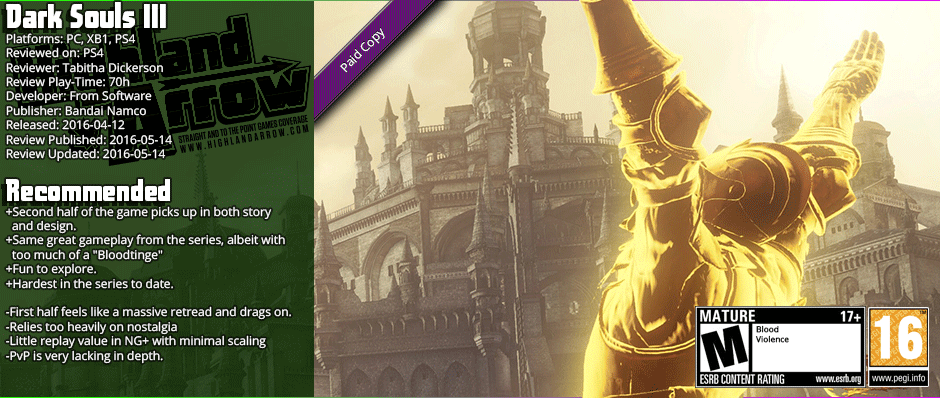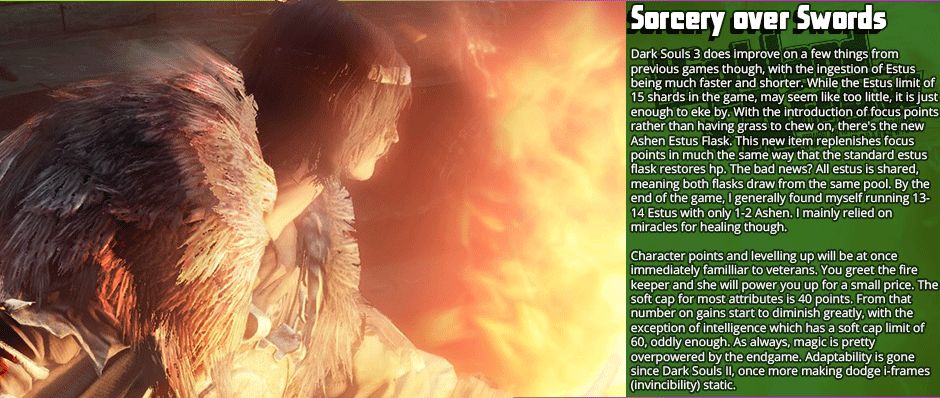

Dark Souls 3 is the latest installment of the Dark Souls series of action RPG games developed by From Software and published by Bandai Namco. Dark Souls 3 is a divisive title, and drawing from previous iterations in the series so heavily, it feels somewhat wrong. Familiar enemy types dot the screen, however this time round, they feel obsolete, almost as if the the slow strategic gameplay the series is known for doesn't quite gel with the frantic fast-paced combat that seems to have become so prevalent since the release of Bloodborne. That isn't to say Dark Souls 3 is a bad game, but it definitely will sort out the die hard fans of the series style, from anyone looking for a fun, challenging rpg title.
The strength remains the minimalist story design,
but Dark Souls 3 takes quite some time to get started
Dark Souls 3 is as always, well written but ambiguous. Nothing is handed to you. In fact, nothing is really given to you until roughly halfway through the game. This can make Dark Souls 3 drag on from the start, and this lack of motivation reveals a weakness in the narrative. Most previous questions in the series have been answered and while From Software probably did the best they can, the truth is there wasn't a lot to work with. The story plays out with you as the Unkindled. The Age of Fire is coming to an end and like always, a bell has tolled. Four Lords of Cinder — godlike beings with powerful souls to link the fire — have awoken from their slumber. You the Unkindled, have risen from your own slumber this cycle as the Ashen One. You were chosen for the task of bringing the Lords back, forcibly if necessary.
Like previous titles in the series, the story is told via minimalist methods. Flavor text dots each and every item, weapon, armor and spell you will locate within the game's world. This sadly is where the story falls somewhat short. While Hidetaka's signature storytelling method of leaving the gaps up to imagination is present here, it's also lacking for the first half of the game. You'll find yourself at the fight with the first Lord of Cinder around about the time parts of the story fall into place. The first half of Dark Souls 3 feels quite bare, taking a long time to build up to any crescendo. While it's not bad per se, it leaves half of the game feeling quite bare, and you with a sense of lack of accomplishment.
The second half of the game however, picks up quite noticeably and more or less delivers on certain new elements previously teased, while answering some long left lingering questions of the series. The information contained within the items from this point starts to become less vague, further fleshing out the truth behind the whole of the Dark Souls series. Not only is there more voice acting, but special items purchased from an NPC named Ludleth usually contain a large info dump about the major players of Dark Souls 3, as do shop armor pieces. This for me made the story quite hit and miss, and far more difficult to piece together, as nothing substantial is really revealed until you defeat even three of four major bosses in the game.
A fairly faster pace
and the return of the 'magic bar' are the chief adds
The gameplay of Dark Souls 3 likewise, draws more from the Bloodborne dynamic, incorporating much faster paced combat. Battles often consist of fast twitch reactions, relying more on reflexes at times than learnt patterns. Stamina works a lot more like Bloodborne, replenishing much faster, and ensuring your ability to dodge, regardless of the stamina spent for attacks. This aspect left me feeling as though From Software could have left stamina out entirely and just implemented some cort of combo system for attacking.
Apart from the faster pace, the magic bar from Demon's Souls makes a return in the new game, however, it is also required for weapon skills. What are weapon skills I hear you ask? Weapon skills are a genuinely new aspect of combat that is unique only to Dark Souls 3. Every piece of weaponry, including staff weapons and defense implements require not just stamina to activate. The magic bar (or Focus Points as the game refers to it) is used during a weapon's special skill. Some weapons are exempt from having their skill use up FP though, like the series mainstay of parrying with shields. This time around, not all shields can actually parry. Large shields like Tower Shields have more defensive skills, and while some medium shields are able to parry enemy attacks, it's no longer ideal. Medium shields require much more finesse and split second timing now to parry, while small shields —while unable to block physical attacks 100%— provide far more of a window in order to parry an enemy's physical attack and are ideal for the task.
The problem with shields however, is that they are just unnecessary. I know that the series of Dark Souls all comes down to specific play-style preferences, but I personally found myself rarely using shields. Apart from one or two annoying sections involving projectiles aimed at me, I relied on my dodge for most of the game. The amount of invincibility frames are pretty crazy, and can be increased with a special item. This for me at least, made shields feel redundant, unless I felt like parrying just for fun.

Combat imports many of the strengths
and weaknesses both of past titles
The boss fights too draw on the dynamic combat of Bloodborne, requiring quick thinking as opposed to the slower, more strategical methodology of previous Souls titles. While there's none of the recycling of specific bosses that was so rampant in Dark Souls II, the variety of move sets they utilize feels tapped out. Most boss strategies boil down to either keeping yourself facing their back, or hugging their knees and dodging at the right time. This caused some boss fights to feel old hat, despite how impressive some of them were visually in both design and scale. A particular highlight of the game is the very first boss, which is easily one of (if not) the toughest intro fights in the series, since the Vanguard from Demon's Souls.
Multiplayer bares some resemblance to the previous titles however, with the use of a special item, games can consist of up to 6 players (3 summons, 3 invaders). With the number of different covenants available, this can often lead to situations where invaders looking to be Kindled will be facing off against 4 or 5 different people out for their blood. Naturally, this can make playing as an invader at times unfair and highly unbalanced. Playing cooperatively is very much the same as 1 and 2, with a summon not only being Kindled (soft humanity) upon defeating a boss in the host world, but also receiving an Ember (Solid Humanity) for their trouble.
Multiplayer online is somewhat inconsistent however, with every single encounter lagging to the point that it took 2-3 seconds to register any of my attacks. The lag never got so bad, that I found myself constantly back-stabbed though, I have it on good authority from US based players that the level of latency I encountered was more or less strictly due to my national network and not in fact an issue inherent within From Software's online servers. While the weapon skills do add a new aspect towards pvp, playing against others players felt quite fruitless in its rewards. With the exception of one or two covenants, and the lore that accompanied association with them, the rewards felt lacking, with the multiple tiers from previous games non-existent.
Dark Souls 3 lends liberally from its predecessors
The visuals of Dark Souls 3 are much more in line with the first game. The first half features the sorts of sprawling set-pieces we've all come to know from From Software's dark universe. There's settlements, forests, and castle fortresses to name some of the more boring pieces. The colour palette present for this part of the game hardly differs much and aside from the occasional vista laid out before your eyes, and some spectacular looking boss fights, it's all fairly standard fare you'd expect.
The level design interestingly enough borrows more from Dark Souls 2, favoring more fragmented and disjointed level progression rather than the sensible, accessible layout of the first title. Aesthetically most of the game seems designed to remind you of previous areas and fights from the first game, without being identical. Sadly while it makes sense, this choice comes off as a bit tactless, with the game constantly pulling up an enemy or two from your past and reminding you of previous game's events. Past enemies make an appearance here or there in the oddest places, and while they still pose somewhat of a threat, it feels like they're now obsolete in comparison to the new dangers that have sprung up across Lothric Kingdom. The whole aspect gave me the feeling that From Software didn't have anything left up their sleeve apart from constantly reminding me of NPC's, or locations from a previous, much better designed game.
The problem at this point in the series is that when you get down to the core formula for aesthetics and gameplay elements, nothing really feels new. Graphically the game is very impressive and looks great. The models are crisp, the frame-rate was generally steady and aside from the odd out of place overly stretched out wall texture, everything looks great. Special mention goes to the vista from the bonfire just before the first boss, as well as when leaving the area of Carthus. Granted the Boreal Valley feels a little too much to me like I'm strolling through the streets of Yharham again, but it still looks fantastic.
The audio design as always is quality. Certain familliar musical cues play during the bosses to convey similar emotions and feelings of deja vu as you face off against certain opponents. Some of the music will be instantly recognizable, while other tracks take a backseat and don't become so apparent until you really listen. One particularly interesting thing I really enjoyed however, was towards the end of the game, some of the sound effects that accompanied certain boss move sets were very recognizable. It's through this use of older sound-bytes and leitmotif the game creates a rather large soundscape of familiarity.
A familiar dance
That's just the problem though. Most of Dark Souls 3 feels to me, like one big retread. Enemies suspiciously similar to those from Bloodborne crop up here and there, as do invader NPC's from the past. Nothing feels like it differs substantially the way it did in Dark Souls II. By the end, the entire game starts to become a tad grating, constantly relying on nostalgia to push it forward, rather than letting it try and stand on its own two feet. What little bits of the story are present are great. The way the game finally delivered on a plot thread I thought forgotten way back in the first game was brilliant. The second half of the game's story was still interesting, albeit heavily disjointed (and that's if you can even find it). Ultimately, Dark Souls 3 only answers one or two lingering questions and brings a whole new throng of mystery to what was the series ending, leaving it not on a cliffhanger, but feeling somewhat incomplete. Hopefully the DLC planned later on in the year will reveal a bit more about the disjointed nature of the world of dark Souls 3, but i'm not holding my breath.
If you're looking for another helping of the "Souls" experience, then look no further than Dark Souls 3. It will satiate a hardcore Soul fan's cravings for the most part. If you're like me however, and couldn't forget how brilliant Bloodborne was in both design and narrative, you may just be let down, feeling as though Dark Souls 3 doesn't have quite enough of its own identity left to be of any worth. It's not a bad game. Hell, I'd even go so far as to say it is a great game, but it just doesn't quite live up to the task of being the final sendoff for such an epic and thought provoking series of rpg games.
 " title=" " class="review-footer" />
" title=" " class="review-footer" />
